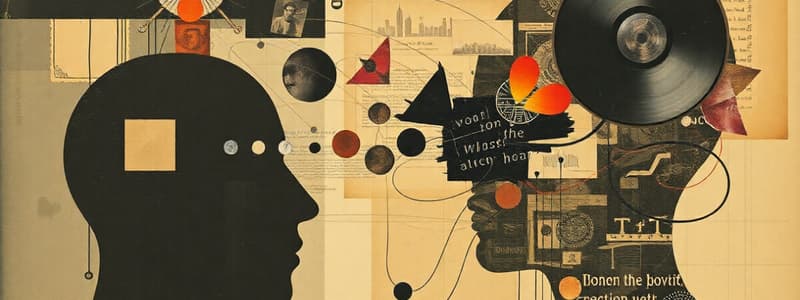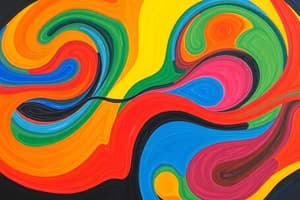Podcast
Questions and Answers
Sensation involves senses and is transmitted to the ______.
Sensation involves senses and is transmitted to the ______.
brain
The ______ threshold refers to the maximum physical energy a sensory receptor can handle.
The ______ threshold refers to the maximum physical energy a sensory receptor can handle.
Terminal
The ______ is the transparent protective window of the eye.
The ______ is the transparent protective window of the eye.
Cornea
The ______ measures the intensity of sound vibrations.
The ______ measures the intensity of sound vibrations.
The sense of smell is known as the most ______ and important of the senses.
The sense of smell is known as the most ______ and important of the senses.
The ability to perceive pressure, warmth, cold and pain are functions of the ______ sense.
The ability to perceive pressure, warmth, cold and pain are functions of the ______ sense.
Sound intensity is often described in terms of its ______ dimension.
Sound intensity is often described in terms of its ______ dimension.
The ______ of sound refers to where a sound is coming from.
The ______ of sound refers to where a sound is coming from.
Trichromats have a ______ vision system, allowing them to see a wide range of colors.
Trichromats have a ______ vision system, allowing them to see a wide range of colors.
Psychokinesis is the ability to ______ physical objects using the mind.
Psychokinesis is the ability to ______ physical objects using the mind.
Flashcards
Sensation
Sensation
The process of receiving information from the environment through our senses and sending it to the brain.
Psychophysics
Psychophysics
The study of how people perceive their sensory responses to stimuli.
Terminal Threshold
Terminal Threshold
The maximum amount of physical energy that can be detected by our senses.
Differential Threshold
Differential Threshold
Signup and view all the flashcards
Perception
Perception
Signup and view all the flashcards
Visible Spectrum
Visible Spectrum
Signup and view all the flashcards
Rods
Rods
Signup and view all the flashcards
Cones
Cones
Signup and view all the flashcards
Closure
Closure
Signup and view all the flashcards
Proximity
Proximity
Signup and view all the flashcards
Study Notes
Sensation
- The process of receiving information from the environment through our senses and transmitting it to the brain.
- The physical stimulus is the first psychological stage of sensation.
- Psychophysics is the study of how people's sensory responses to stimuli are perceived.
- Electromagnetic radiation includes all forms of light, from infrared to ultraviolet.
- Terminal threshold refers to the maximum amount of physical energy that can be detected by the senses.
- Differential threshold is the minimum amount of energy needed to detect a change in stimulus.
- Sensory adaptation is the process of becoming less sensitive to a constant or repeated stimulus.
Physiology of Sensation
- Modality refers to the different categories of sensation, such as vision, hearing, touch, etc.
- Quality describes the different types of experiences within a sensory modality, like the color of light or a particular smell.
- Intensity measures the strength or degree of a sensation.
- Duration refers to the length of time a sensation lasts.
- Reaction time is the time interval between the presentation of a stimulus and the response to it by a person.
Perception
- Perception involves interpreting and organizing sensory information to make sense of the world around us.
- Visual perception goes beyond just capturing light and involves interpreting the information our eyes collect.
Visual Perception
- The visible spectrum of light ranges from 400 to 800 nanometers.
- Light travels at 186,000 miles per second.
- The human eye can't see the infrared, radar, and radio waves that are beyond 800 nanometers.
- The cornea is the transparent protective outer layer of the eye.
- The pupil is the dark hole in the center of the iris.
- The iris is the colored part of the eye that controls the amount of light entering the pupil.
- The lens is located behind the pupil and focuses light onto the retina.
- The retina is a thin layer of nerve cells at the back of the eye that converts light into neural messages.
- Rods are long and cylindrical photoreceptor cells that are sensitive to low light levels.
- Cones, short and thick photoreceptor cells, are responsible for color vision and are sensitive to brighter light.
- The fovea is the most sensitive area of the retina, responsible for sharp central vision.
- The optic nerve carries visual information from the retina to the brain.
Perceptual Organization
- Closure refers to the tendency to perceive incomplete figures as complete.
- Proximity indicates that objects that are close together are perceived as belonging to a common group.
- Similarity suggests that objects that share visual characteristics, such as shape, color, or texture, are perceived as forming a group.
- Simplicity implies that we tend to perceive the simplest possible organization of elements.
- Figure-ground perception involves separating an object (figure) from its background.
- Linear perspective refers to the convergence of parallel lines as they extend into the distance.
- Atmospheric perspective is the blurring of objects in the distance due to the scattering of light by air.
- Superimposition describes the obscuring of one object by another.
- Light and shadow play a role in depth perception, with brighter objects appearing closer than those in shadow.
- Texture gradient describes the change in texture as objects become further away.
Color Perception
- Color perception is based on the wavelength of light.
- Hue or quality is determined by the wavelength of light.
- Saturation refers to the purity of light.
- Brightness is the intensity of light.
Hearing
- Sound involves the movement of air molecules.
- Frequency refers to the number of vibrations per second and determines pitch.
- Amplitude refers to the amount of contraction or expansion of air molecules and determines the loudness of sound.
- Decibels are the units used to measure the amplitude of sound.
- Trichromats have normal color vision.
- Dichromats are color blind and lack one of the three types of cones, resulting in a deficiency in distinguishing one of the three dimensions of color.
- Monochromats are totally color blind and only have one type of cone.
Anatomy of the Ear
- The outer ear functions like a reverse megaphone, collecting sound waves.
- The auditory canal is a passage that channels sound waves to the eardrum.
- The eardrum vibrates in response to sound waves.
- The middle ear is a tiny chamber containing three small bones: the hammer, anvil, and stirrup.
- These bones act as levers to transmit vibrations from the eardrum to the oval window.
- The oval window is a thin membrane that separates the middle ear from the inner ear.
Perception of Sound
- Pitch is determined by the frequency of a sound.
- Intensity refers to the loudness of a sound.
- Timbre or tone quality is determined by the harmonics or overtones present in a sound.
- The direction of a sound is determined by the relative intensity of the sound reaching each ear.
- The distance of a sound can be determined by its frequency composition and the relative intensity reaching each ear.
Auditory Selectivity
- We can selectively attend to certain sounds in a noisy environment, despite the presence of many other sounds.
Smell
- Smell is a primitive and important sense.
- Volatility indicates how easily a substance vaporizes.
- Fat-solubility refers to the ability of a substance to dissolve in fats.
- Olfactory cells are receptors for smell located in the olfactory epithelium.
- The olfactory epithelium lines the nasal cavity from the nostrils to the throat.
Taste
- Taste receptors are located on the tongue and palate, responsible for detecting sweet, salty, sour, and bitter tastes.
- Sweet tastes are detected at the tip of the tongue.
- Salty tastes sensations occur near the area behind the sweet receptors.
- Sour tastes are detected on the sides of the tongue.
- Bitter tastes are detected at the rear of the tongue.
Skin Sense (Somesthesis)
- Somesthesis refers to the sense of touch.
- The skin contains different types of sensory receptors, each sensitive to specific stimuli.
- Four types of sensory spots are found in the skin:
- Warmth stimuli
- Cold stimuli
- Pressure stimuli
- Pain stimuli
Muscle Sense (Kinesthesis)
- Kinesthesis refers to our awareness of body movement and position.
Sense of Equilibrium
- The sense of equilibrium provides information about our overall body position and balance.
Extra Sensory Perception (ESP)
- ESP refers to the alleged ability to perceive information outside of the normal sensory channels.
- Telepathy is the claimed ability to transfer thoughts from one person to another.
- Clairvoyance is the supposed ability to perceive events or objects at a distance.
- Precognition is the purported ability to predict future events.
- Psychokinesis is the alleged ability to influence physical objects with the mind.
Studying That Suits You
Use AI to generate personalized quizzes and flashcards to suit your learning preferences.




